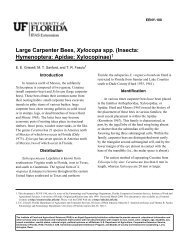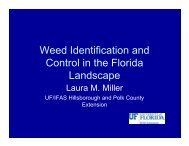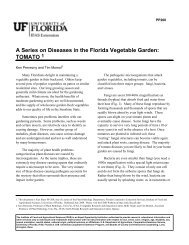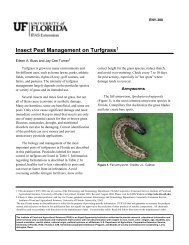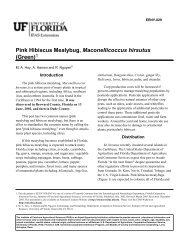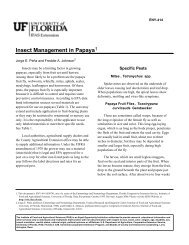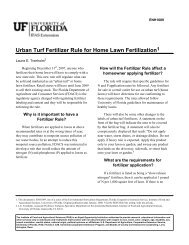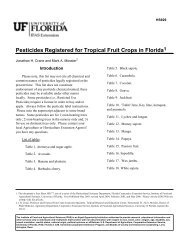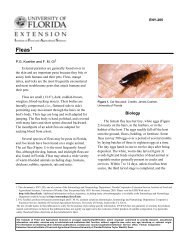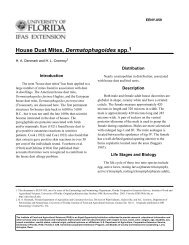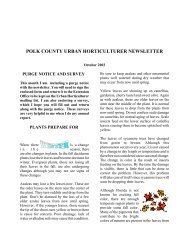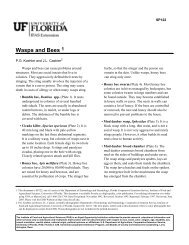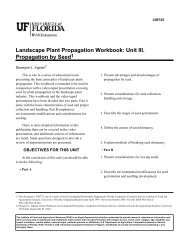Warm Climate Production Guidelines for Bougainvillea 1
Warm Climate Production Guidelines for Bougainvillea 1
Warm Climate Production Guidelines for Bougainvillea 1
You also want an ePaper? Increase the reach of your titles
YUMPU automatically turns print PDFs into web optimized ePapers that Google loves.
ENH 874<br />
<strong>Warm</strong> <strong>Climate</strong> <strong>Production</strong> <strong>Guidelines</strong> <strong>for</strong> <strong>Bougainvillea</strong> 1<br />
Richard Schoellhorn and Erin Alvarez 2<br />
Figure 1.<br />
Introduction<br />
Common Name: <strong>Bougainvillea</strong>, Paper Flower<br />
Scientific Name: <strong>Bougainvillea</strong> glabra<br />
Family: Nyctaginaceae<br />
Along with palms, sunshine, and beaches, the<br />
cascading blooms of <strong>Bougainvillea</strong> provide one of<br />
Florida's signature tropical images (See Figure 1).<br />
As a profuse bloomer, <strong>Bougainvillea</strong> is most striking<br />
during the winter, when it is at its peak and few other<br />
plants are able to provide color. Although it is<br />
frost-sensitive and hardy in zones 9b and 10,<br />
<strong>Bougainvillea</strong> can be used as a houseplant or hanging<br />
basket in cooler climates. In the landscape, it makes<br />
an excellent hot season plant, and its drought<br />
tolerance makes <strong>Bougainvillea</strong> ideal <strong>for</strong> warm<br />
climates year-round. Native to the coasts of Brazil,<br />
<strong>Bougainvillea</strong> has a high salt tolerance, which makes<br />
it a natural choice <strong>for</strong> south Florida and other coastal<br />
regions. As a woody clambering vine, <strong>Bougainvillea</strong><br />
will stand alone and can be pruned into a standard, but<br />
it is perfect along fence lines, on walls, in containers<br />
and hanging baskets, and as a hedge or an accent<br />
plant. Its long arching branches are thorny, and bear<br />
heart-shaped leaves and masses of papery bracts in<br />
white, pink, orange, purple, and burgundy (See Table<br />
1). Many cultivars, including double flowered and<br />
variegated, are available (See Table 2).<br />
<strong>Production</strong><br />
pH Preference<br />
<strong>Bougainvillea</strong> does best with a slightly acidic soil<br />
pH of 5.5-6.0.<br />
Media<br />
<strong>Bougainvillea</strong> has an extremely fine root system,<br />
and should be planted in well-drained soils. Avoid<br />
soil mixes with high peat levels and water retention.<br />
These types of media retain too much water and will<br />
1. This document is ENH 874, one of a series of the Environmental Horticulture Department, Florida Cooperative Extension Service, Institute of Food and<br />
Agricultural Sciences, University of Florida. Original publication date October 1, 2002. Visit the EDIS Web Site at http://edis.ifas.ufl.edu.<br />
2. Richard Schoellhorn, Associate Professor; Erin Alvarez, Student Assistant, Environmental Horticulture Department, Institute of Food and Agricultural<br />
Science, University of Florida, Gainesville, Fl 32611.<br />
The Institute of Food and Agricultural Sciences is an equal opportunity/affirmative action employer authorized to provide research, educational<br />
in<strong>for</strong>mation and other services only to individuals and institutions that function without regard to race, color, sex, age, handicap, or national origin.<br />
For in<strong>for</strong>mation on obtaining other extension publications, contact your county Cooperative Extension Service office. Florida Cooperative<br />
Extension Service/Institute of Food and Agricultural Sciences/University of Florida/Christine Taylor Waddill, Dean.
<strong>Warm</strong> <strong>Climate</strong> <strong>Production</strong> <strong>Guidelines</strong> <strong>for</strong> <strong>Bougainvillea</strong> 2<br />
contribute to root rot; be sure to select a well-draining<br />
media.<br />
Light Levels<br />
As a tropical plant, <strong>Bougainvillea</strong> requires full<br />
sun, or a light level of at least 4000 f.c. Most growers<br />
keep hanging baskets at the top of the greenhouse <strong>for</strong><br />
maximum light exposure.<br />
<strong>Production</strong> Temperatures<br />
Temperatures should be maintained somewhat<br />
high; a minimum of 65 o F at night and 75 o to 95 o F<br />
during the day. Crop scheduling will be delayed at<br />
cool temperatures, especially if the soil is also cool.<br />
Fertilization<br />
At planting, provide a fertilizer that is high in<br />
phosphate, and follow with a balanced liquid fertilizer<br />
at 150-300 ppm. Nitrogen and phosphate are critical<br />
to flowering, but do not overfertilize; too much<br />
fertilizer will add growth, but will inhibit blooming.<br />
Magnesium and iron deficiencies are common, but<br />
apply a complete micronutrient blend or chelated<br />
spray with caution, as too much of either Mn or Fe<br />
will cause the other to be unavailable to the plant, and<br />
will result in a deficiency. Micronutrient applications<br />
can be used at 1/2 the recommended rate at two times<br />
to avoid toxicity.<br />
Propagation<br />
Propagate this plant from cuttings, but<br />
propagation can be slow and difficult due to<br />
<strong>Bougainvillea</strong>'s extremely fine root system.<br />
<strong>Bougainvillea</strong> roots best from semi-hardwood<br />
cuttings 5-9 nodes in length. Take softwood cuttings<br />
if you are propagating when night temperatures are<br />
above 55 o ; hardwood cuttings when night<br />
temperatures are below 55 o F. Treat cuttings with<br />
between 3000 and 6000 ppm IBA. Remove leaves<br />
from all portions of the stem that will be<br />
underground. Some research suggests that thicker<br />
cuttings with higher concentrations of auxin produce<br />
better rooting; however, high levels of auxin may<br />
result in stunted branching. Bottom heat will speed<br />
rooting. Intermittent overhead mist is required;<br />
cuttings must never be allowed to wilt. High relative<br />
humidity must be maintained around the plants at all<br />
times. Time to rooting is 6-12 weeks. Transplant<br />
young plants with caution to avoid damaging the<br />
roots, and always apply a broad-spectrum fungicide<br />
drench when planting cuttings and again after<br />
transplanting to prevent root rot.<br />
Pinching Required<br />
Pinch plants at 4 weeks to shape them, or pinch<br />
to a stake <strong>for</strong> taller plants. Dikegulac can be used at 2<br />
fl oz/gal, or Atrimmec ® at 1 fl oz/gal <strong>for</strong> a chemical<br />
pinch that will stimulate new branch growth and<br />
subsequent flowering.<br />
Plant Growth Regulators<br />
The need <strong>for</strong> and effects of plant growth<br />
regulators vary greatly depending on a number of<br />
factors. It is always recommended that growers test<br />
plant growth regulators be<strong>for</strong>e use. Always follow<br />
label instructions. Growers have reported success<br />
with Paclobutrazol at 20-40 ppm when plants are near<br />
salable size.<br />
Photoperiod/Flowering<br />
Blooms occur only on new growth, so new<br />
growth on plants is vital to the achievement of<br />
flowering. <strong>Bougainvillea</strong> normally flowers during the<br />
short days of winter, but blooms are highly dependent<br />
on temperature. Drought stress can also stimulate<br />
flowering even with long daylight exposure. Growers<br />
frequently allow plants to dry just to the point of<br />
wilting to induce flowering. However, excessive<br />
drying can cause leaf drop and dormancy; use care<br />
and be sure to water at first signs of wilt.<br />
Plants Per Pot<br />
Plant one liner per gallon container, one or two<br />
liners <strong>for</strong> an eight inch hanging basket, and three<br />
liners per ten- to twelve-inch hanging basket.<br />
Scheduling<br />
Allow twelve to sixteen weeks <strong>for</strong> <strong>Bougainvillea</strong><br />
to grow from a liner to a finished one-gallon plant or<br />
hanging basket, depending on temperature and light<br />
levels. (See Table 1)
<strong>Warm</strong> <strong>Climate</strong> <strong>Production</strong> <strong>Guidelines</strong> <strong>for</strong> <strong>Bougainvillea</strong> 3<br />
Common Problems<br />
• Irregular flowering is a major concern <strong>for</strong><br />
growers, who often use drought stress to<br />
encourage blooming. Variety choice can be<br />
extremely helpful in remedying this problem,<br />
however.<br />
• Leaf drop can be a problem as a result of<br />
over-watering, under-watering, low light levels,<br />
or cold temperatures.<br />
• Root rot is easily prevented by careful handling<br />
and by the application of a broad spectrum<br />
fungicide drench during transplanting or planting<br />
in the landscape.<br />
• New growth yellowing or chlorosis is often a<br />
result of a magnesium or iron deficiency, and an<br />
application of a complete micronutrient blend or<br />
chelated spray should help, but use caution—too<br />
much of either Mn or Fe will result in a<br />
secondary deficiency, as the plant is unable to<br />
absorb one when the other is present at high<br />
levels.<br />
• For old growth chlorosis, apply Epsom salts at<br />
1-2 tsp/gal as a drench or foliar spray.<br />
Landscape Culture<br />
<strong>Bougainvillea</strong> is a wonderful addition to any<br />
landscape, whether it's used as a permanent fixture, a<br />
container plant or hanging basket in a semi-tropical<br />
landscape, or an annual in cooler climates. For the<br />
best per<strong>for</strong>mance out of your <strong>Bougainvillea</strong>, follow<br />
these guidelines:<br />
• Keep <strong>Bougainvillea</strong> on the dry side, especially if<br />
you want lots of blooms. Too much water will<br />
promote root rot and cause leaves to drop. Don't<br />
water on cool nights.<br />
• Use a high-bloom fertilizer.<br />
• Plant or place <strong>Bougainvillea</strong> in full sun. As a<br />
potted plant, flowers will last <strong>for</strong> up to eight<br />
weeks if kept in a sunny location.<br />
• Winter dieback may be a problem if the weather<br />
gets too cool, so if you're growing <strong>Bougainvillea</strong><br />
in a frost-prone area, plant in a protected<br />
location or cover in case of frost.<br />
Other Resources <strong>for</strong> <strong>Bougainvillea</strong><br />
In<strong>for</strong>mation<br />
"http://hendry.ifas.ufl.edu/<br />
HCHortNews_<strong>Bougainvillea</strong>.htm"<br />
"http://www.bougainvilleas.com/"<br />
"http://pine.usask.ca/cofa/departments/hort/hortinfo/<br />
plants/bougainv.html"<br />
"http://bougainvillea.freeyellow.com/<br />
bougainvillea.html"
<strong>Warm</strong> <strong>Climate</strong> <strong>Production</strong> <strong>Guidelines</strong> <strong>for</strong> <strong>Bougainvillea</strong> 4<br />
Table 1. Rough table of production times <strong>for</strong> <strong>Bougainvillea</strong><br />
Time Stage of <strong>Production</strong><br />
6-12 weeks Rooting/propagation – depending on propagation techniques<br />
12-16 weeks 1 - Liner to gallon<br />
12-16 weeks 1-2 Liners per 8” hanging basket<br />
14-20 weeks 3 - Liners per 10-12” hanging basket<br />
20-50 weeks Liner to 3-5 gal nursery containers & trellises<br />
50-100 weeks From liner to larger nursery containers and specimen plants<br />
*Actual production time varies with light, temperature, and fertilizer regimens.<br />
Table 2. Commonly produced <strong>Bougainvillea</strong> Cultivars and their primary uses<br />
For Landscape Use<br />
'Barbara Karst' Large bright red bracts. A most popular standby that always per<strong>for</strong>ms well. Almost constant<br />
bloomer.<br />
'Mrs Butt' Red to peach bracts. This is a buttiana cultivar. Large repeat bloomer.<br />
'Miami Pink' Dark pink bracts. Does best in the landscape.<br />
'Tropical Bouquet' Orange but quickly becomes pink. Compact and bushy.<br />
'Cali<strong>for</strong>nia Gold' Large, long-lasting gold bracts. Can be considered as yellow in some environments. Nice vining<br />
habit.<br />
'Royal Purple' Dark purple bracts. Good replacement <strong>for</strong> Elizabeth Angus in humid areas.<br />
For Containers/Hanging Baskets<br />
'Helen Johnson' A dwarf red. Compact and bushy grower. Branches freely. Good <strong>for</strong> hanging baskets.<br />
'Juanita Hatten' Red Foilage may be slightly variegated in shades of green. Branches freely. Good <strong>for</strong> hanging<br />
baskets.<br />
'Pink Pixie' True miniature. Small pink bracts. Good <strong>for</strong> small pots.<br />
'Summer Snow' Large, pure white bracts. Excellent <strong>for</strong> weddings. Does very well in hanging baskets.<br />
'Dr. David Barry' Large lavender bracts. Fine <strong>for</strong> containers.<br />
Novelty/Special Interest Cultivars<br />
'Double Red' Deep red. Clusters of fluffy double bracts over nice green leaves.
<strong>Warm</strong> <strong>Climate</strong> <strong>Production</strong> <strong>Guidelines</strong> <strong>for</strong> <strong>Bougainvillea</strong> 5<br />
Table 2. Commonly produced <strong>Bougainvillea</strong> Cultivars and their primary uses<br />
'Raspberry Ice' Red. Variegated foliage. Slow grower. Repeat bloomer.<br />
'Double Pink' Huge clusters of bright pink doubles. Repeat bloomer.<br />
'Surprise' Free blooming pink which may sport white flowers.<br />
'Vicky' Pink bracts. Leaf centers creamy yellow - some white bracts may be sported.<br />
'Golden Summer' White. Variegated yellow-gold foliage. Repeat bloomer.<br />
'Sweet Dream' Leaves are completely gold, bracts are pale lavender. A thornless variety.



